Nauticam ships their housing for the Canon EOS 7D Mark II
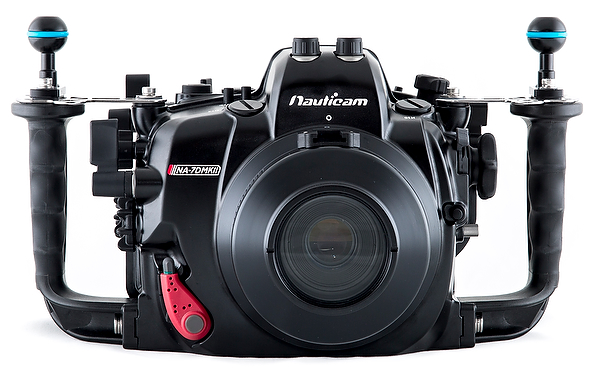
Nauticam has announced their housing for the Canon EOS 7D Mark II camera. If features a dual function lever for ISO and M Fn (focus area adjustment) and a button to allow the vacuum system to be reset from the front. It features Nauticam’s multi selector pad, and for the first time on a Nauticam housing for a Canon camera, a lever to activate or deactivate the camera’s flash.
The NA-7DMkII is shipping now at a U.S.A. retail price of $3,400.
Press release
New Housing for Canon 7D Mark II Performance Digital SLR
Nauticam is pleased to announce it’s underwater camera housing for the Canon 7D Mark II, the NA-7DMKII. The production, ready-to-dive NA-7DMKII made it’s debut at the 2014 Dive Equipment Manufacturers Association trade show in Las Vegas, Nevada, November 19th - 22nd.
The Canon 7D Mark II
With the 7D Mark II, Canon has reconfirmed its commitment to the APS-C sensor, which is welcome news for discerning photographers who value the APS-C sensor size and its benefits for underwater use. This is a performance camera in every sense of the term… blazing fast 10 frames per second, exceptionally fast phase detection fast autofocus, dual pixel video autofocus, 60fps video and much more.
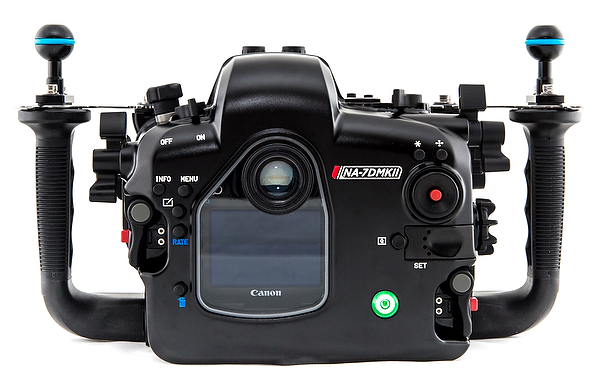
Of course, the 7D II has big shoes to fill. The original 7D, launched in 2009, was a smash hit for Canon, and at the time redefined the market for APS-C cameras, especially in regard to autofocus and shooting speed. The 7D Mark II picks up that baton and advances it well. The camera features a 20MP CMOS sensor and has dual DIGIC 6 image processors. The result of using this fast and modern processor is the ability to shoot at 10 frames per second in continuous drive mode, as well as capture HD video (IPB, ALL-I, or Light IPB) at 59.94 fps.
The autofocus system gets a huge upgrade: 65 AF points (all “cross-type”) together with an updated set of options for subject types, subject tracking and more. Video autofocus is an updated version of the Dual Pixel CMOS system that was introduced with the Canon 70D. The dual pixel approach proved itself useful for underwater shooters with the 70D, allowing for both simple focus tracking or more advanced techniques like focus pulls.
Also of interest to underwater photographers, the 7D Mark II Auto ISO is now programmable and allows for exposure compensation when shooting in manual. This is a valuable feature for underwater videographers as it allows control over over shutter speed and aperture, yet will automatically adjust ISO smoothly as the scene changes from from dark to light.
The NA-7DMKII Housing
It Is clearly true that the NA-7DMKII is an improvement over the original NA-7D housing, but Nauticam has come so astonishingly far in the last 5 years that this really is not a useful comparison. The NA-7D was an important housing for Nauticam (see the sidebar about that), but Nauticam SLR housings have advanced considerably. Take for example the housing latches. The NA-7D was the last Nauticam housing to use the “old school” stainless steel buckle style latches. The NA-7DMKII takes advantage of the simple yet secure locking latches that have since become famous. These latches are more secure, effortless to close, and eliminate the knuckle busting snap of the old buckles. The NA-7DMKII represents the ideal example of current Nauticam housing design.
Nauticam’s patented Port Locking Lever is as simple to operate as ever, enabling easy port changes without twisting or excessive force. A vacuum reset button inside the port mount also allows the vacuum system to be quickly reset from the port mount making quick lens changes a snap. These touches further reduce the stress of proper gear preparation and allow more time for diving.
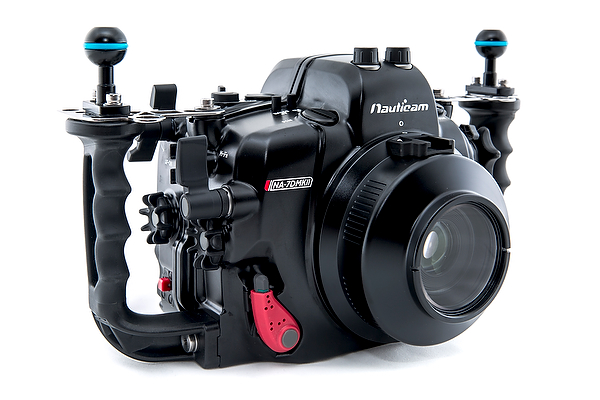
Added to these now standard features are ergonomic refinements that further enhance the imaging experience for both still photo and motion imaging enthusiasts. A new dual function lever under the right handle brings ISO and M Fn (used for AF area pattern) out to the fingertips of the user. Nauticam’s signature multi selector pad, found on the Nikon line and NA-70D, provides easy access to all 65 focus points and the ability to move on the diagonals without stair stepping. All of the core functions needed to operate the camera are at the users fingertips, and available by feel.
The NA-7DMKII is the most refined Nauticam SLR housing to date. Every camera function is made easier by careful thought and design, aided by input from photographers who will actually use this camera. The housing borrows the best from recent housings like the NA-D810 and the NA-5DMKIII, and incorporates new enhancements to key exposure controls for both video and still photo users.
New to the Nauticam housings for Canon SLR’s, the NA-7DMKII will feature a lever to activate or deactivate the camera’s popup flash. While this task can be accomplished in the Canon menus, it is easier and faster to disable or enable flash with this lever.
A Personal Note
The Canon 7D holds a very special place in the collective hearts at Nauticam, and for me personally. While it was not the very first camera that Nauticam produced a housing for (housings for the Nikon D90 and D300 preceded it), the 7D was really the camera that put Nauticam on the map. For 4 years, the NA-7D was our bestselling housing, both in terms of units and dollars. To me, the NA-7D represents the genesis of Nauticam’s unique ability to innovate in underwater camera housings. And while the D90/D300 were a terrific start, I am generally a Canon shooter. So if you don’t mind, as we talk about the awesome new 7D Mark II, I’d like to get a little bit nostalgic about the 7D for a moment.
The first time I got my hands on a Canon 7D, one thing struck me - Canon had done what many of us had long hoped for - it had taken professional level autofocus and put it in a camera that was much more manageable than their pro 1D series. It was substantially better autofocus than even their 5D Mark II that had just been released less than a year earlier - faster and more accurate. And while I’d shot the 5D for several years, I have always thought that the APS-C sensor size is ideal for underwater use, and that the extra reach, and smaller wide angle lenses is very useful for topside use as well. I wanted, no, I needed this camera.
In 2010, I managed to get a hold of one of the very first production NA-7D housings. I’d used a prototype on a few dives, but this housing was ready to go diving. It was mine, and I sunk my claws in it and didn’t let go. Looking back, I am amazed at how good the ergonomics were. The housing fit my hands like a glove. Yes, today, the newer designs are even better, but keep in mind that previously, ergonomics on underwater camera housings were totally an afterthought. Before I started with Nauticam, I owned about 6 different housings. While they all had the basics, i.e. you could turn dials and press the shutter, the designs were very rudimentary. But with the NA-7D, someone actually thought about how the hand is positioned on the housing, and how each and every button is used by actual u/w shooters. That attention to detail and to the needs of the operator really started a revolution.
After the first few NA-7D’s shipped, Nauticam did something that, while it sounds fairly ordinary, was in fact quite the opposite. They revised the housing. They changed the design, adding locks to the housing latches and an improved shutter, among other things. Logistically, that is not an easy thing to do for a company. But Nauticam bit the bullet, and did it. New customers got the benefit of the new designs, and many of the existing customers got updates - at no charge. To me, that is when I knew I had signed on to a winning company. The team was not willing to sit idly by. On the contrary; they were moving the innovation bar forward. This company has not stopped since… if anything, the pace of innovation and continued improvement has accelerated. Nauticam came “out of nowhere” (through hard work and determination), and is now the most successful underwater imaging equipment manufacturer on the planet.
And it all started with the 7D.
So please, excuse my sentimentality here. Goodbye 7D, and hello 7D Mark II. I can’t wait to see what amazing images people are able to make with this new version of an old friend.
Chris Parsons Waxing nostalgic at 35,000 feet.
The APS-C Advantage
What is it about the APS-C sensor size that makes it so ideal for underwater photographer, especially as compared to the 36x24mm full frame sensors? Simply put, it’s lenses. First, for macro, the APS-C yields more “reach” with a given macro lens, and more choices; in particular the Canon EF-S 60mm macro which does not work on Canon’s full frame cameras. The fully kitted macro shooter with the 7DII might have 3 macro lenses, the aforementioned 60mm, the Canon 100m f/2.8 IS L macro, and the Sigma 150mm f/2.8 macro. That is an impressive choice in macro lenses and, by adding a close-up converter lens like the Nauticam Super Macro Converter (SMC), covers the entire spectrum of the macro world, from fish portraiture to the tiny world of super macro.
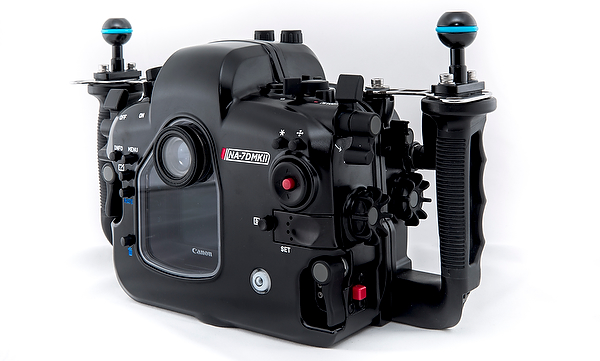
For fisheye wide angle lenses, APS-C again offers advantages, specifically two of the best and most versatile wide angle lenses available for use underwater. The Tokina 10-17mm is a favorite among underwater photographers, and for good reason. When used on an APS-C camera, this a super-wide 180º fisheye at 10mm, but when zoomed to 17mm the fisheye distortion is greatly reduced and the lens becomes excellent for close-focus-wide-angle or more distant subjects with a 110º fov. The Canon 8-15, used with it’s APS-C range of 10-15mm, is very similar in it’s versatility and produces even sharper images with less aberration.
For rectilinear wide angle, again, the APS-C sensor provides an advantage, this time due to dome port optics. As full frame shooters are aware, it can be a challenge to get sharp corners when using a wide angle rectilinear lens like the Canon 16-35mm. For APS-C, Canon offers the much less expensive 10-22mm and 10-18mm lenses. When these are used with a large dome like the Nauticam 8.5” acrylic dome or the Nauticam 230mm glass dome it is considerably easier to get sharp images, especially in the corners.
Canon 7D Mk II Key Features
- 20 Megapixel APS-C CMOS Sensor with Dual Pixel AF Technology.
- 10 fps continuous shooting with autofocus
- 65 point autofocus, all cross type sensors
- 150,000 RGB + IR pixel metering sensor
- Dual Digic 6 processors
- Enhanced environmental sealing
- Dual memory card slots, one CF and one SD
- Built in GPS
- Larger capacity LP-E6N Battery
- 1920 x 1080 High Definition Video at up to 60 fps
- Clean 4:2:2 Video Over HDMI for use with external recorders
NA-7DMKII Feature Checklist
- Unsurpassed build quality, designed by an award winning engineering team, and produced utilizing the most modern manufacturing technology available
- Ergonomically placed controls with size, shape, and color differentiation
- Access to all key camera controls
- All controls clearly labeled
- Patented two stage shutter release system, allowing precise feel over half press and full press
- Patented Port Locking System
- Patent pending Multi Controller pad
- Lens release button
- Easy to operate locking housing latches
- Rubberized ergonomic grips
- Quick release camera mounting plate
- Optical strobe connectors for fiber optic flash triggering
- Dual M16 accessory holes for electrical bulkhead, HDMI, hydrophone, or vacuum valve installation
- Single M16 accessory hole for vacuum valve installation
- Integrated vacuum monitoring and leak detection circuit (valve optional)
- Vacuum reset button in port mount for quick lens changes
- Dual 1” (25mm) strobe mounting balls included as standard equipment
- 1/4-20 tripod mounting holes
- Dual 10mm threaded accessory mounting points
- .66x optical glass pickup finder (magnifying 180 and 45 viewfinders available optionally)
- 100m Depth Rating
- Integrated Vacuum Check and Leak Detection System
The Nauticam vacuum check and leak detection system is available with NA-7DMKII as standard equipment. Combined with an optional vacuum valve, this monitoring system provides constant updates on the water tight and safe to dive status of the housing. A simple coded LED lighting system lets the user know that the vacuum is solid, or that the housing is losing vacuum. Leak detection is built into the same circuit, so if there is water intrusion, an audible and visual indication will occur. The NA-7DMKII ships with a 3rd bulkhead port specifically for installing optional vacuum valves, leaving the user two other bulkhead ports for HDMI, sync cables and other accessories.
Viewfinders
Precision requires vision: A high resolution camera like the Canon 7D MkII demands perfect focus for optimal results. Fortunately, Nauticam has developed the most user-friendly interchangeable viewfinders available.
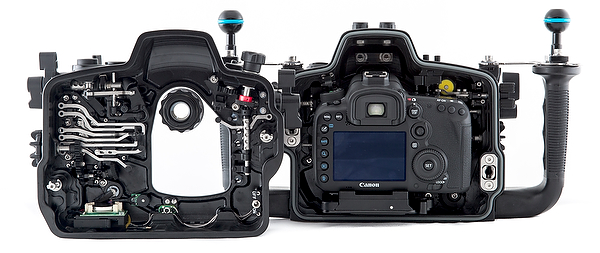
The standard optical glass viewfinder is very good and travel friendly, but many photographers prefer the ease of a magnified viewfinder with adjustable diopter. Nauticam produces a “straight” 180º enlarging viewfinder and a 45º angled enlarging viewfinder to enhance the ease of close quarters work often associated with macro shooting. Both viewfinders have high quality optics, and allow bright viewing of the entire image. A patented external dioptric adjustment allows personal adjustment to a sharp-as-a-tack standard underwater and viewfinder changes can be executed in less than 30 seconds without using tools. Exceptional composition and focus accuracy have never been more accessible.
Recommended Accessories
- 180º Enhancing Viewfinder (32201)
- 45º Enhancing Viewfinder (32203)
- Patent Pending Super Macro Converter (81201), providing 2.3:1 reproduction ration with the popular AF-S 105mm /2.8G VR Macro Lens
- Vacuum Valve (25612)
- Complete line of flat and dome ports for all major lenses, available in acrylic and glass
- Locking port extension rings from 10mm to 70mm.
- Monitor/Recorder Housing for Atomos Ninja2 (17902)
- Monitor Housing for SmallHD DP4 Monitor (17901)
- Fiber optic cables for Inon (26211) and Sea&Sea (26212)
- Full line of mounting accessories for lighting, including mount balls, strobe adapters, arms, clamps, and specialty items
- Multiple styles of lanyards
- Lens holders, including flip-up
- Focus and Zoom gears for many Nikon, Tokina, and Sigma lenses
- Port Adapters for Aquatica, Ikelite, Inon, Nexus M5 & M6, Sea & Sea NX, Seacam, Subal Version 3 & 4, and Zillion
- Handle accessories including smaller handles, handle extensions for cold water diving
- Optical Flash Trigger for continuous shooting without reliance on electrical cables.
Details and Specifications
Depth Rating: 100m
Weight: 2.90 kg (with handles mounted)
Dimensions (with handles mounted): 353 (W) x 191(H) x 124(D)
Model Number: 17319
USA Retail Price: $3400
Shipping: November 27, 2014
More information is available from Nauticam USA. A full USA dealer list is also available.
Contact Nauticam USA:
Chris Parsons
Nauticam USA
2303 N. Andrews Ave.
Ft. Lauderdale
FL 33311.
Phone: 954-489-8678. Web. Email.
About Nauticam:
About Nauticam: Nauticam is the world’s leading manufacturer of innovative, ergonomic imaging solutions. Founded in 2009 by Edward Lai, an underwater photographer with two decades of experience making precision injection molds, Nauticam has continued to raise the bar with every new model release. Nauticam’s goal is to provide the absolute best user experience possible. Nauticam USA is the exclusive wholesale distributor of Nauticam products in the North and South American Markets. Nauticam USA’s warehouse and service center is located in Fort Lauderdale, FL. Our staff of underwater photography experts strives to provide the best customer support and after sale service available. Dealer inquiries are welcome! Inquiries:
Please email for dealer enquiries Outside of North & South America.
See here for an International Dealer Listing.
Or here for dealers in the Americas.